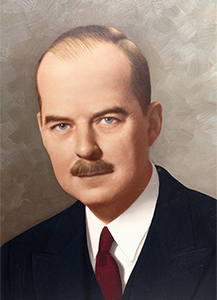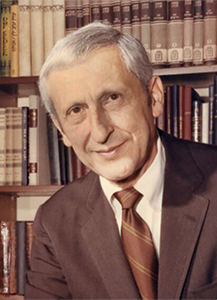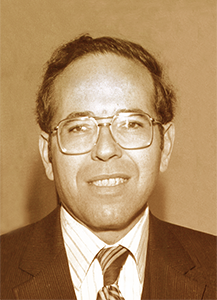
 The New York City Office of the Actuary311
The New York City Office of the Actuary311 Search all NYC.gov websites
Search all NYC.gov websites

George B. Buck
Chief Actuary (1916-1956)
His Legacy
He fundamentally believed that if the monies of a retirement system were held in trust for the purpose for which they were contributed, they stood the test of time. He was right.
New York City’s First Chief Actuary, George B. Buck, was a pioneer in developing sound retirement plans for public employees. The New York City Retirement Systems and Pension Funds, as we know them today, were built on Mr. Buck’s tenacity, beliefs, and unwavering commitment to protecting the retirement systems of New York City’s workers. In fact, at the time of his death when running his own private actuarial firm, Mr. Buck was serving as the actuary for over 700 clients, consisting of public retirement systems and private companies. As depicted in Margaret Allen Burt’s recorded history of Mr. Buck’s life in the manuscript, "George B. Buck Consulting Actuaries, Inc. - The First 45 Years," New York City’s first Chief Actuary was well respected by his peers, considered fair, and always a leader. He was resolute in being a protector of public retirement systems, having a hand in creating many of them, including those outside the purview of New York City.
The Early Years
Even as a child, Mr. Buck demonstrated leadership and management skills, often telling his mother he had no time to play because he had to manage his own neighborhood-based businesses that included everything from growing and selling mushrooms to furniture repair. This work ethic demonstrated at a very young age served him well in later years as a law school student at George Washington University and an admitted attorney to the Washington D.C. Bar.
Initial Public Pension Work
At age 20 in 1911, Mr. Buck was asked to serve with Herbert D. Brown on President Taft’s Commission on Economy and Efficiency to review the retirement of superannuated employees, during a time when there were no retirement systems for public employees in the United States that operated on an actuarially sound basis. Formal pension plans were in place, but the contributions by the employees and the government were arbitrary. Several theories related to the organization of retirement systems were explored, focusing primarily on employee contributions and contribution rates based on age.
Following his work on the Commission, in 1912, the firm of Brown and Buck was formed. It was the first office organized for the purpose of specializing in the establishment and valuation of employee benefit funds. After working on an actuarial report for the New York City Police Pension Fund, the first government actuarial report prepared by Mr. Buck, the partnership ended in 1913.
Establishing New York City Pensions
In 1914 Mr. Buck was hired by the New York City Pension Fund Commission to be its actuary for valuing the nine then-existing separate pension funds.
At the time, these nine systems were not funded well and described in the above-mentioned manuscript as being "in chaotic condition." In this role, Mr. Buck departed from original theories being discussed in the Taft Commission which focused on employee-only contributions. Instead Mr. Buck pursued designing a retirement system that included three basic principles:
Principal 1: Joint Contributions - Public retirement plans should have joint contributions from both the employees and the employer.
Principal 2: Full Reserve Basis - The employer’s contributions should be made during the active service of employees, at a rate such that with interest it produces reserves sufficient to provide the benefits.
Principal 3: Uniform benefits - The retirement benefits should be uniform throughout the City.
Accidental death and accidental disability plans were also being discussed, with street cleaners incurring the most incidents.
In 1916, Mr. Buck completed the valuation of each fund, determining the total liability of the entire system, and issued the "Report on the Pension Funds of the City of New York." This report laid the groundwork to establish New York City’s first retirement system.
The first retirement system formed in New York City under Mr. Buck’s leadership was the Teachers’ Retirement System and he served this system as the Chief Actuary. This happened in 1917 and was followed by him assuming the Chief Actuary duties of the additional City retirement systems formed. He was the City’s First Chief Actuary until 1956, providing actuarial services to the systems formed during that time period.
The Teachers’ Retirement System was the first retirement system in the United States for public employees that provided the reserve basis for both the members’ and the City’s contributions. It was set up like a separate corporation, with a Board acting as trustee to guarantee that the benefits for which monies were held in trust would be paid to teachers. Separate accounts within the System were set up to explicitly hold the City and the teachers' contributions.
Other Pension Contributions
In addition to his actuarial duties for the City’s pension funds, in 1916 Mr. Buck began his own firm, George B. Buck, Consulting Actuary, after many entities asked for his guidance in setting up retirement systems. His clients included New Jersey Teachers, New York State Employees, New York State Teachers, and the YWCA.
Mr. Buck died on April 12, 1961 at his home in Larchmont, New York.

Jesse Feld
Chief Actuary (1961-1973)

Jonathan Schwartz
Chief Actuary (1974-1986)

Robert C. North, Jr.
Chief Actuary (1990-2014)

Sherry S. Chan
Chief Actuary (2015-2022)

Michael J. Samet
Interim Chief Actuary (January 2022 - September 2022)

Marek Tyszkiewicz
Current Chief Actuary


